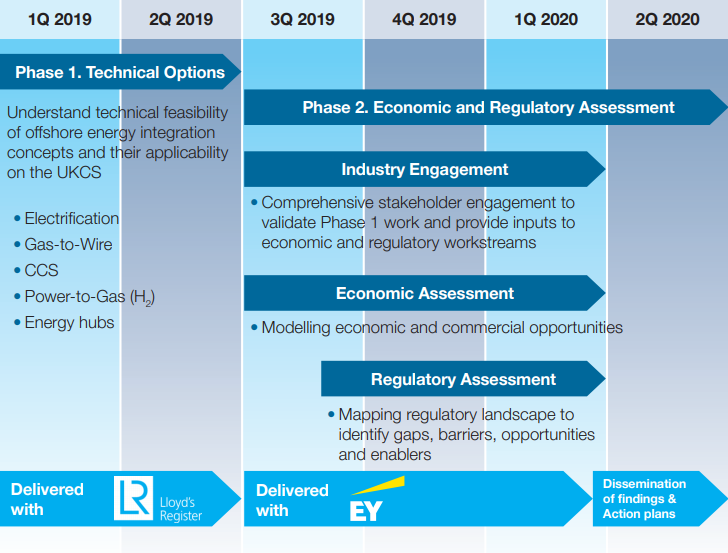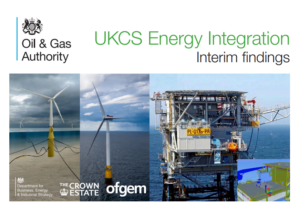The “UKCS Energy Integration: Interim Findings” as issued by The Oil and Gas Authority, which was published on Tuesday 17 December 2019, discusses the first phase of the UKCS Energy Integration Project, led by the OGA; BEIS; The Crown Estate as well as Ofgem, considering options to help feed into a new strategic vision of the UKCS as an integrated energy basin.
The project funded by a grant from the Regulators’ Pioneer Fund, considers how oil and gas infrastructure and capabilities can be leveraged for carbon capture and storage (CCS), and to support renewable energy production and hydrogen generation; transportation and storage.
[smlsubform prepend=”GET THE SAFETY4SEA IN YOUR INBOX!” showname=false emailtxt=”” emailholder=”Enter your email address” showsubmit=true submittxt=”Submit” jsthanks=false thankyou=”Thank you for subscribing to our mailing list”]
In fact, the report provides interim findings from phase 1 of the OGA’s Energy Integration Project, and also comprises a scoping study undertaken by Lloyd’s Register to consider the technical feasibility of oil and gas assets, together with renewable sources, to enable the transition to a low carbon economy. It further reviewed five technology concepts: platform electrification, carbon capture and storage (CCS), gas-to-wire, hydrogen and energy hubs.
Alison Kerlogue, LR’s expert voice on Energy Integration underlined that “as an industry, the approach we’re taking in developing sustainable energy sources has made significant strides in the last 12 to 18 months. Historically asset owners retirement and decommissioning plans have failed to recognize potential reuse and integration options. The OGA’s report identifies the solutions that will help drive the transition to an energy mix that embraces renewable sources using existing oil and gas infrastructure, the concepts of which can be used anywhere in the world not just the UKCS.”
What is more, the report found that multiple offshore integration concepts are technically feasible and would be viable options for helping to lower the oil and gas industry’s carbon footprint and decarbonizing the UK economy.
All the concepts discussed in the report can potentially help in reducing carbon dioxide emissions but differ in terms of scalability and timeline; namely, the report emphasizes that opportunities for UKCS deployment are many; diverse and location specific.
Specifically, assimilating withing the UK offshore energy sector, such as linking between oil and gas and renewables, can help in reducing carbon emissions from oil and gas production and in the long-term, actively support delivery of the UK’s net zero target through technologies such as carbon capture and storage (CCS).

It is said that the UK has significant wind power potential; untapped carbon storage capacity; and extensive oil and gas infrastructure in place.
Some of the concepts discussed include:
- Platform electrification to significantly reduce emissions on oil and gas installations by using low-carbon electricity, including directly from offshore wind farms; to replace generation from gas and diesel. Technology for platform electrification has been proven and could enable near-term emissions reductions for the oil and gas industry.
- Gas-to-wire (GtW) can enable gas to be converted to electricity offshore and transported using existing windfarm cables. In terms of technical feasibility, individual elements are proven, but it is a niche solution especially for the Southern North Sea (SNS) and East Irish Sea (EIS). Yet, GtW can be combined with CCS to avoid the incremental CO2 emissions.
- CCS has already been piloted offshore and is considered essential in all UK decarbonization scenarios, not just to decarbonize the power sector but also to enable deep cuts from other sectors, including industry.
- Hydrogen has feasible production avenues through both ‘blue’ hydrogen, produced by natural gas reforming, and ‘green’ hydrogen- electrolysis produced by renewables- routes, enabling decarbonization of power, heat and transport. Additionally, the offshore energy sector – both oil and gas and renewables – offer significant production, storage and transport potential, for instance through the repurposing of offshore oil and gas infrastructure and offshore electrolysis, with transportation in re-used pipelines.
- Offshore energy hubs can help scaling up net-zero energy solutions, such as allowing hydrogen to be generated offshore using windfarms and stored in reservoirs to be transported to shore using oil and gas infrastructure; sites across the UK can be suited to energy hubs.
The OGA now supports the energy transition and welcomes the government’s legally binding commitment to net zero emissions by 2050 and understands why there could be concern about UK domestic production of oil and gas in this context.
Yet, oil and gas will remain an important part of our energy mix for the foreseeable future, including under net zero scenarios, where the UK is still expected to be a net importer. Thus, managing the declining production and maximizing the economic recovery from the UK remains vital to meet those energy demands if they exist, and to reduce reliance on hydrocarbon imports.
Andy Samuel, Chief Executive of the OGA stated that
The energy transition and the UK’s drive to net zero requires the oil and gas industry to embrace energy efficient operations, whilst supporting the growth of CCS, offshore renewables, and hydrogen. Our report highlights the wide range and combination of solutions that can play a part, in line with the Committee for Climate Change’s recommendations. Phase II is well underway, focusing on regulatory and economic aspects and we look forward to working closely with industry and government in enabling action through 2020 ahead of COP 26.
The OGA has now appointed EY to support delivery of phase two of the project, which consists of an economic and regulatory assessment, to identify barriers, opportunities and quick wins. The project will conclude in Q2 2020, after which a final report will be published.

Adding to this, in June, The Offshore Wind Industry Council (OWIC) launched a ten-year programme to support the growth of UK businesses looking to capitalize on the opportunities offered by offshore wind. The GBP 100 million project is planned to support more than 650 British companies to access the domestic offshore wind market and create further opportunities to enter the global market.
More recently, the UK Prime Minister, Boris Johnson, made promises on increasing the country’s offshore wind power, adding that the UK should raise its goal for offshore wind power to 40 gigawatts (GW) by 2030, up from the current 30 GW target and invest 500 million pounds ($640 million) in electric vehicle charging points, as Reuters reported.
Specifically, Boris Johnson highlighted that no home will be more than 30 miles away from an electric vehicle charging point. To achieve this goals, almost 800 million pounds should be invested in technology to capture and store carbon dioxide.
To find out more about the recently published “UKCS Energy Integration: Interim Findings”, you can click on the PDF bellow.































































